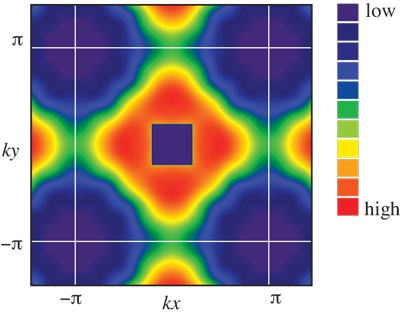Abstract
- Electrons in high-temperature cuprate superconductors were believed to have the two-dimensional motion for the past 35 years. Contrary to this belief, NIMS, Hokkaido University, JASRI, and Tohoku University revealed that the electronic state in cuprates is characterized by a superposition of the one-dimensional motion along the x and y direction. This new finding is expected to be an important hint to elucidate the mechanism of high-temperature superconductivity in cuprates.
- A lot of efforts have been made to achieve superconductivity, i.e., zero electrical resistance, at higher temperatures, which will solve some of the global energy issues. In particular, cuprate superconductors attract much interest because of their high transition temperatures and a characteristic layered structure of copper–oxygen (CuO2) planes. A key to resolve the issue lies in the observation of the Fermi surface, which directly reflects the motion of electrons inside the material. Extensive studies by angle-resolved photoemission spectroscopy (ARPES) implied that the Fermi surface is two dimensional. Hence most of researchers believed that electrons in cuprate superconductors take the two-dimensional motion in the x-y plane. Strictly speaking, however, ARPES measured only a portion of the Fermi surface and thus the entire shape of the Fermi surface remained elusive. On the other hand, recently, some theoretical and experimental studies pointed to a possibility of the one-dimensional motion of electrons. This raised a serious question about whether the Fermi surface is really two dimensional as was believed so far, and required a precise measurement of the Fermi surface.
- The research team performed a detailed study of the Fermi surface in La2-xSrxCuO4, one of high-temperature cuprate superconductors, by employing a Compton scattering technique. This technique demands high-intensity and high-energy x-ray, which is available only at SPring-8, the world’s largest synchrotron radiation facility. The research team succeeded for the first time in showing experimental evidence that the electronic state in cuprates is characterized by a superposition of the one-dimensional motion of electrons. That is, electrons have a preferred direction along either x or y axis in each CuO2 layer and the preferred direction alternates between the layers. Since the crystal structure of La2-xSrxCuO4 is composed of the stack of the CuO2 layers, the resulting electronic state is described by their superposition. This finding turned over the conventional idea believed for 35 years that the Fermi surface should be two dimensional in cuprates.
- In the future, the research team plans to deepen the present work and to explore how the superposition of the one-dimensional motion of electrons evolves into the high-temperature superconductivity by collaborating with other techniques such as ARPES. Obtained insights will boost a basic research to develop quantum materials for next-generation quantum computers using high-temperature superconducting materials. In addition, the Compton scattering technique allows one to perform a detailed study of electronic states for a wide range of materials. The research team plans to employ this technique to observe electronic states in magnetic refrigeration materials, which are believed to be a key to develop a cost-efficient hydrogen liquefaction system, and aims to contribute to the development of a “hydrogen society” from an electronic point of view.
- This project was carried out by Hiroyuki Yamase (Principal Researcher, Quantum Material-Properties Group, International Center for Materials Nanoarchitectonics, NIMS; also Visiting Professor, Department of Condensed Matter Physics, Hokkaido University), Yoshiharu Sakurai (Japan Synchrotron Radiation Research Institute) and Masaki Fujita (Professor, Institute for Materials Research, Tohoku University).This work was supported by various projects such as “Study of the Fermi surface in cuprates by complementary use of Compton scattering and angle-resolved photoemission spectroscopy” (funding source: JSPS Grant-in-Aid for Scientific Research (B), project number: JP20H01856) and “Development of an advanced hydrogen liquefaction system by using magnetic refrigeration technology” (funding source: JST-Mirai Program, project number: JPMJMI18A3). This work was published in Nature Communications, an open access journal, at 10:00 am on April 13, 2021, GMT (7:00 pm on April 13, Japan Time).

Figure: Electron momentum distribution n(k) measured by Compton scattering experiments. The high (low) intensity indicates large (small) electron occupancy. The Fermi surface is located along the boundary between the high and low intensity, and the intensity should be nearly constant along the Fermi surface. Detailed analyses of this data showed that the Fermi surface is described by a superposition of the one-dimensional motion of electrons along the x and y direction, not by the two-dimensional motion in the x-y plane believed so far.
Publication Details
Title
Fermi surface in La-based cuprate superconductors from Compton scattering imaging
Authors
Hiroyuki Yamase, Yoshiharu Sakurai, Masaki Fujita, Shuichi Wakimoto, Kazuyoshi Yamada
Journal
DOI
Online publication date
April 13, 2021
Press release online (in Japanese)
PDF: 1.21MB
